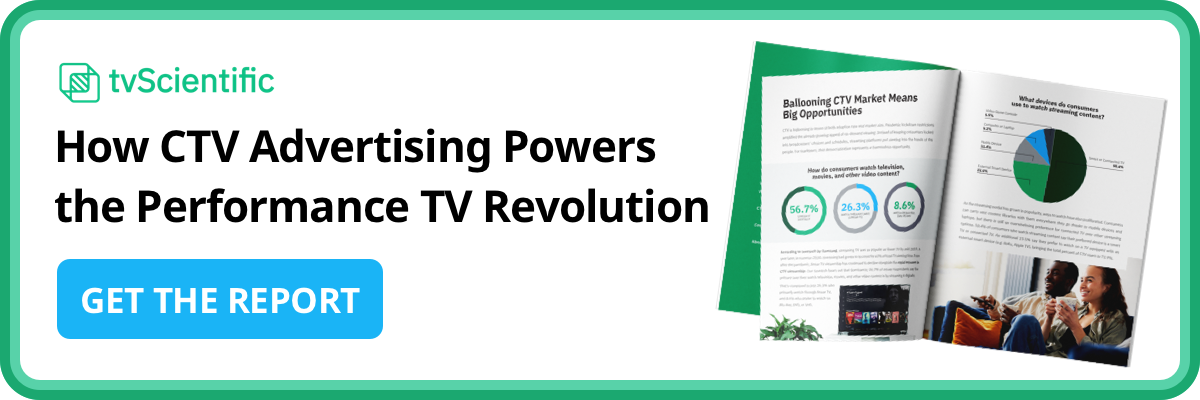Find out which demand generation metrics every advertiser should keep an eye on.
Find out which measures make a marketer
CTV (connected TV) advertisements are the new cool kid in the marketing world. Spend on streaming ads in the US grew by 21.2% this year — a natural move as more viewers are turning to free ad-supported streaming (FAST) TV for affordable entertainment. But how can you be sure your campaigns are landing with the audience? Which demand generation metrics should you track? This guide breaks down demand generation KPIs to keep your eye on.
Discover strategies, metrics, examples and more with The Complete Guide to Demand Generation.
What Does Demand Generation Actually Mean?
Different definitions of demand generation abound, but at its core, demand gen is an education-focused, long-term marketing strategy to get new audiences interested in your product. It’s meant to build excitement and teach potential clients about your offerings, instead of getting them to buy something on the spot (so very much the opposite of an 80s car dealership commercial). In the world of CTV advertising, that means curating creative content that hits the right notes with the audience, grabs their attention, and manages to be educational at the same time. But once an ad runs, how do you know if it’s working?
Measuring ad engagement on linear TV has historically been a challenging experience. The vague “brand awareness” term got tossed around, but getting detailed data, besides basic rankings was nearly impossible. Not so for CTV. Having access to a connected TV platform allows marketers to get in-depth insights about how their audience is reacting to their ads. Given this new plethora of information, the question pivots to which demand generation metrics matter most. If you’re curious about the big-picture outlook of performance TV advertising, you may want to read our market research report next for a more detailed discussion.
8 Demand Generation Metrics to Prioritize in 2023
MQL Lead Conversion Rates
Audience members become market-qualified leads (MQLs) when there is enough evidence to suggest they’re interested in making a purchase. For CTV ads, that could mean an audience member engaging with an ad by scanning a QR code, or completing another action, like visiting your website to sign up for a newsletter High MQL lead conversion rates mean you’re successfully getting more people interested in your brand, even if they’re not quite ready to make a purchase. On the other hand, lackluster MQL conversion could mean you’re not quite getting the right tone or speaking the same language as your targeted demographic.
SQL Conversion Rates
Sales qualified leads (SQLs) are further down the funnel than MQLs and have indicated that they are ready to make a purchase through some significant action, like requesting a demo or signing up for a free trial. Of course, the higher the conversion rate, the better. Keep in mind that re-engagement campaigns are equally important in CTV ads as they are on mobile or other platforms. You’ll need to retarget your MQLs with more detailed creative if you want to keep their attention and convince them that your product is indeed right for them.
Cost Per Acquisition (CPA)
Your CPA rate should be lower than the revenue generated from new users (or the CLV, discussed later in the article). It may be the less obvious of the demand generation metrics to track, but can help you gauge if you’re pouring energy and money into a campaign that is not working. CPA is typically calculated by dividing the cost of a campaign by the number of conversions on a desired action.
Ad Completion Rate
The ad completion rate tells you the percentage of viewers who watch your ad all the way through (without leaving the streaming service or otherwise interrupting their experience). Ad completions are an important demand generation KPI since they tell you how well people are tolerating your ads. Tolerating may not sound like the nicest way to describe it, but since there’s no way of knowing if audiences are using the ad time to get a cup of tea or check their email, it’s your best approximation of engagement without more concrete conversion items. A high ad completion rate usually correlates with higher MQL rates, so your success with one is inherently tied to another.
Engagement With Emails and Social
Watching opening and click-through rates on emails and tracking likes and especially shares on social following a CTV campaign can give you a pretty good idea of whether or not people are resonating with your ads. In fact, a positive correlation between CTV ads and social engagement has been found, which means that particularly successful campaigns should give you a boost on social — if you discover this correlation, this is a great demand generation metric to point out in a quarterly report, since it indicates increased engagement across channels.
Return on Investment (ROI)
Besides conversions, new leads, or resulting increases in revenue, measuring your ROI includes figuring out your pay-back period. You’ll want to know how long it takes for you to make back the upfront costs of winning a paying user. This is typically calculated by dividing the cost per acquisition (CAC) by the average revenue per account per month (ARPA). Ideally, your pay-back period should not exceed 12 months. A shorter pay-back period means that your ads are converting faster and are therefore more efficient at generating leads.
Marketing Cycle Length
The average length of your marketing cycle tells you how long it takes for a user to make their way through the marketing funnel and become a paying customer. Benchmarks of what a “good” marketing cycle length should be will vary depending on your industry, but the faster viewers convert from stranger to MQL to SQL to customer, the more efficient your creative placement likely is.
Customer Lifetime Value (CLTV)
CLTV refers to the average revenue you derive per account. Comparing your CLTV numbers before and after running a CTV campaign should help you understand how well your campaign is working. The downside is that this demand generation metric takes time to show up in a meaningful way. Looking at CLTV values a week after you run your ads is probably not going to tell as much as it might if you wait a few months. However, if your ads are converting well and you have a relatively short marketing cycle, your CLTV value should be going up relatively quickly.
Invest in Tools That Put Demand Gen Metrics at Your Fingertips
Thanks to the near-universal popularity of streaming services and the proliferation of connected TVs, many more marketers can now exclaim “Mom, I’m on TV! (My ad, that is.)” tvScientific helps make TV advertising accessible to all brands by providing an intuitive performance platform that makes it easy to run, measure, and track your ad performance. Want to see how it works? Reach out to our team for a demo.







